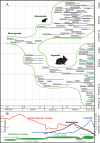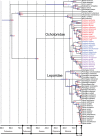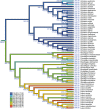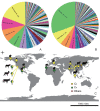Evolutionary history of lagomorphs in response to global environmental change
- PMID: 23573205
- PMCID: PMC3616043
- DOI: 10.1371/journal.pone.0059668
Evolutionary history of lagomorphs in response to global environmental change
Abstract
Although species within Lagomorpha are derived from a common ancestor, the distribution range and body size of its two extant groups, ochotonids and leporids, are quite differentiated. It is unclear what has driven their disparate evolutionary history. In this study, we compile and update all fossil records of Lagomorpha for the first time, to trace the evolutionary processes and infer their evolutionary history using mitochondrial genes, body length and distribution of extant species. We also compare the forage selection of extant species, which offers an insight into their future prospects. The earliest lagomorphs originated in Asia and later diversified in different continents. Within ochotonids, more than 20 genera occupied the period from the early Miocene to middle Miocene, whereas most of them became extinct during the transition from the Miocene to Pliocene. The peak diversity of the leporids occurred during the Miocene to Pliocene transition, while their diversity dramatically decreased in the late Quaternary. Mantel tests identified a positive correlation between body length and phylogenetic distance of lagomorphs. The body length of extant ochotonids shows a normal distribution, while the body length of extant leporids displays a non-normal pattern. We also find that the forage selection of extant pikas features a strong preference for C(3) plants, while for the diet of leporids, more than 16% of plant species are identified as C(4) (31% species are from Poaceae). The ability of several leporid species to consume C(4) plants is likely to result in their size increase and range expansion, most notably in Lepus. Expansion of C(4) plants in the late Miocene, the so-called 'nature's green revolution', induced by global environmental change, is suggested to be one of the major 'ecological opportunities', which probably drove large-scale extinction and range contraction of ochotonids, but inversely promoted diversification and range expansion of leporids.
Conflict of interest statement
Figures







Similar articles
-
Molecular phylogeny of Japanese Leporidae, the Amami rabbit Pentalagus furnessi, the Japanese hare Lepus brachyurus, and the mountain hare Lepus timidus, inferred from mitochondrial DNA sequences.Genes Genet Syst. 2002 Apr;77(2):107-16. doi: 10.1266/ggs.77.107. Genes Genet Syst. 2002. PMID: 12087193
-
Early Eocene lagomorph (Mammalia) from Western India and the early diversification of Lagomorpha.Proc Biol Sci. 2008 May 22;275(1639):1203-8. doi: 10.1098/rspb.2007.1661. Proc Biol Sci. 2008. PMID: 18285282 Free PMC article.
-
Comparative morphology of premolar foramen in lagomorphs (Mammalia: Glires) and its functional and phylogenetic implications.PLoS One. 2013 Nov 21;8(11):e79794. doi: 10.1371/journal.pone.0079794. eCollection 2013. PLoS One. 2013. PMID: 24278178 Free PMC article.
-
An overview of the South American fossil squamates.Anat Rec (Hoboken). 2014 Mar;297(3):349-68. doi: 10.1002/ar.22858. Epub 2014 Jan 31. Anat Rec (Hoboken). 2014. PMID: 24482358 Review.
-
An overview of the lagomorph immune system and its genetic diversity.Immunogenetics. 2016 Feb;68(2):83-107. doi: 10.1007/s00251-015-0868-8. Epub 2015 Sep 23. Immunogenetics. 2016. PMID: 26399242 Review.
Cited by
-
Expertly validated models and phylogenetically-controlled analysis suggests responses to climate change are related to species traits in the order lagomorpha.PLoS One. 2015 Apr 15;10(4):e0122267. doi: 10.1371/journal.pone.0122267. eCollection 2015. PLoS One. 2015. PMID: 25874407 Free PMC article.
-
The complete mitochondrial genome of the 'Zacatuche' Volcano rabbit (Romerolagus diazi), an endemic and endangered species from the Volcanic Belt of Central Mexico.Mol Biol Rep. 2022 Feb;49(2):1141-1149. doi: 10.1007/s11033-021-06940-7. Epub 2021 Nov 16. Mol Biol Rep. 2022. PMID: 34783988
-
Incorporating Genome Annotation Into Genomic Prediction for Carcass Traits in Chinese Simmental Beef Cattle.Front Genet. 2020 May 15;11:481. doi: 10.3389/fgene.2020.00481. eCollection 2020. Front Genet. 2020. PMID: 32499816 Free PMC article.
-
Convergent Loss of the Necroptosis Pathway in Disparate Mammalian Lineages Shapes Viruses Countermeasures.Front Immunol. 2021 Sep 1;12:747737. doi: 10.3389/fimmu.2021.747737. eCollection 2021. Front Immunol. 2021. PMID: 34539677 Free PMC article.
-
Trypanosoma (Herpetosoma) diversity in rodents and lagomorphs of New Mexico with a focus on epizootological aspects of infection in Southern Plains woodrats (Neotoma micropus).PLoS One. 2020 Dec 31;15(12):e0244803. doi: 10.1371/journal.pone.0244803. eCollection 2020. PLoS One. 2020. PMID: 33382847 Free PMC article.
References
-
- Hoffmann RS, Smith AT (2005) Order Lagomorpha. In mammal species of the world: A taxonomic and geographic reference. In: Wilson DE and Reeder DM eds. Johns Hopkins University Press, London.
-
- Matthee C, Van Vuuren B, Bell D, Robinson T (2004) A molecular supermatrix of the rabbits and hares (Leporidae) allows for the identification of five intercontinental exchanges during the Miocene. Syst Biol 53: 433–447. - PubMed
-
- McKenna MC, Bell SK (1997) Classification of mammals: above the species level. New York, & Chichester, West Sussex: Columbia University Press. I–xiii, 1–631.
-
- Angermann R, Flux JEC, Chapman JA, Smith AT (1990) Lagomorph classification. In: Chapman JA, Flux JEC, eds. Rabbits, hares and pikas Status survey and conservation action plan: IUCN, Gland, Switzerland. 7–13.
-
- Ge DY, Lissovsky AA, Xia L, Cheng C, Smith AT, et al. (2012) Reevaluation of several taxa of Chinese lagomorphs (Mammalia: Lagomorpha) described on the basis of pelage phenotype variation. Mammal Biol 77: 113–123.
Publication types
MeSH terms
LinkOut - more resources
Full Text Sources
Other Literature Sources
Miscellaneous

